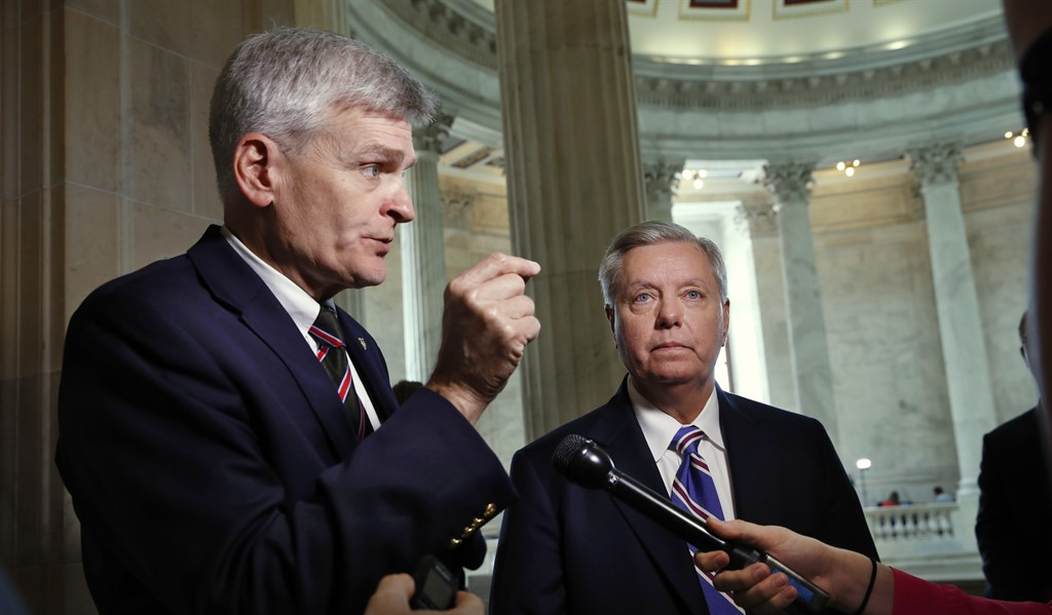Even as Washington is consumed by other matters, Democrats' failing healthcare scheme continues to fall apart. A small cluster of Republicans deserve ample blame for cratering the party's seven-year pledge to repeal and replace the law, and President Trump's Hamlet-esque indecision on cost-sharing subsidies is contributing to a climate of uncertainty that has further spooked carriers. But the majority of the blame rests with the people who wrote, passed, and lied about this terrible law, which was spiraling downward long before Trump won the election. The Senate is now holding bipartisan hearings on potential "fixes" to Obamacare, which may be the only path forward (or maybe not, read below) if the GOP's simple-majority 'reconciliation' window closes at the end of this month. How a cross-aisle compromise might take shape is unclear; Democrats would insist on bailout-style payments to insurers, and in return, Republicans would get...what, exactly? It's all very hazy at the moment. But yesterday's proceedings once again underscored an inescapable reality -- the status quo is harming many Americans:
State officials sounded the alarm Wednesday on Capitol Hill about skyrocketing ObamaCare premiums as insurers across the country propose double-digit rate hikes – renewing pressure on Congress to act. Insurance commissioners and officials from Alaska, Tennessee, Pennsylvania, Oklahoma and Washington state all testified before a Senate committee on the 2018 premium hikes, which are being finalized over the next few weeks. In Alaska, premiums have increased 203 percent since 2013, according to Lori Wing-Heier, the state’s director of the Division of Insurance. “On average, the increase means that an Alaskan in the individual market who was paying a monthly premium of $344 per month in 2013 is paying $1,041 per month in 2017,” Wing-Heier told the Senate Health, Education, Labor & Pensions committee.
Oklahoma Insurance Commissioner John Doak told the panel he has been warning about “spiking rates” for too long and those warnings “have been ignored at the federal level.” “Oklahoma is facing the collapse of our individual health insurance market,” Doak said, adding that the state has seen a rise in premiums of 130 percent over the last four years. And in Tennessee, proposed 2018 premium increases are between 21 and 42 percent, according to Julie Mix McPeak, the commissioner of the Tennessee Department of Commerce and Insurance. “Tennessee consumers will have at least one option for coverage, but only one,” McPeak said, noting that “a single choice” did not represent the state’s “ideal marketplace competition.” “Our consumers have seen premium prices skyrocket while their choices dropped substantially.” McPeak added: “The current Affordable Care Act trajectory is not sustainable.”
Recommended
Since 2013, average premiums on the federal "Affordable" Care Act exchange have shot up by 105 percent. You may recall that pro-Obamacare liberals were recently cheering the news that despite fears that some US counties would have zero insurers participating in 2018 individual marketplaces, those gaps had been filled. The reality remained that roughly one quarter of counties would only have one "choice," and nearly half of all counties are down to two or fewer options -- but one is better than zero, and successes have been few and far between for the "it's working" crowd. So that development was hailed as positive news. Hold the champagne:
More than sixty thousand ObamaCare enrollees in Virginia could be without an insurer next year after Optima Health announced it was leaving many of the state's markets, according to officials in the state. Optima said it plans to exit many of the counties that it served in 2017, after previously planning to cover nearly the entire state next year. The move would leave 63 of Virginia's 95 counties without an insurance option for 2018...Optima also said it would be raising premiums by 81 percent for any customer who doesn’t qualify for subsidies from the federal government...Optima said some of the premium increase was due to uncertainty surrounding federal funding for ObamaCare’s cost-sharing reduction payments. It also said some of the increase was due to other national carriers leaving the state. Anthem, Aetna and UnitedHealth have already announced plans to exit Virginia’s ObamaCare markets entirely next year.
What a mess. Officials may scramble and convince another carrier to cover these freshly-"bare" counties for next year, but the overall trends on coverage and costs still bode quite poorly. Obamacare's weak enrollment is attributable to its unaffordability and lack of choices -- which, in turn, are driven by disproportionately sicker and more expensive risk pools. Because of the law's core mandates, younger and healthier consumers are incentivized to forego insurance until they really need it. The result is an unsustainable and disintegrating dynamic. Real problems, real harm, real people. I'll leave you with this: Is John McCain, who cast the decisive vote to kill the Senate GOP's repeal and replace push, open to a separate plan?
Has McCain resurrected ACA repeal? Not quite, but activists are taking no chances. https://t.co/4iMUfo3K11
— Dave Weigel (@daveweigel) September 6, 2017
The Cassidy/Graham proposal (read that explainer piece, which is packed with useful graphics) will reportedly be submitted to CBO for scoring next week, so stay tuned for that outcome. Even if it's considered for a vote, some conservatives may object that it wouldn't really achieve a true "repeal," because states could opt to essentially maintain Obamacare. Then again, the Obamacare Defense League is treating it like black death:
?? ALERT: McCain has flipped on ACA repeal. All hands on deck. We need to pummel them for the next 24 days. ??https://t.co/naYmFtULJg
— Topher Spiro (@TopherSpiro) September 6, 2017
Let's say, for the sake of argument, that Cassidy/Graham could actually garner 50 Senate votes. As noted above, the reconciliation window slams shut after September 30th. Tick, tick, tick...



















Join the conversation as a VIP Member